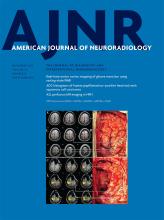Index by author
Bodanapally, U.K.
- LetterYou have accessREPLY:U.K. Bodanapally and O. SaeediAmerican Journal of Neuroradiology November 2017, 38 (11) E101; DOI: https://doi.org/10.3174/ajnr.A5379
Bonafe, A.
- NeurointerventionYou have accessAnterior Circulation Acute Ischemic Stroke Associated with Atherosclerotic Lesions of the Cervical ICA: A Nosologic Entity ApartO.F. Eker, P. Panni, C. Dargazanli, G. Marnat, C. Arquizan, P. Machi, I. Mourand, G. Gascou, E. Le Bars, V. Costalat and A. BonaféAmerican Journal of Neuroradiology November 2017, 38 (11) 2138-2145; DOI: https://doi.org/10.3174/ajnr.A5404
Bosemani, T.
- Pediatric NeuroimagingYou have accessDoes the Addition of a “Black Bone” Sequence to a Fast Multisequence Trauma MR Protocol Allow MRI to Replace CT after Traumatic Brain Injury in Children?M.H.G. Dremmen, M.W. Wagner, T. Bosemani, A. Tekes, D. Agostino, E. Day, B.P. Soares and T.A.G.M. HuismanAmerican Journal of Neuroradiology November 2017, 38 (11) 2187-2192; DOI: https://doi.org/10.3174/ajnr.A5405
Brinjikji, W.
- EDITOR'S CHOICENeurointerventionOpen AccessAngioarchitectures and Hemodynamic Characteristics of Posterior Communicating Artery Aneurysms and Their Association with Rupture StatusB.J. Chung, R. Doddasomayajula, F. Mut, F. Detmer, M.B. Pritz, F. Hamzei-Sichani, W. Brinjikji, D.F. Kallmes, C.M. Jimenez, C.M. Putman and J.R. CebralAmerican Journal of Neuroradiology November 2017, 38 (11) 2111-2118; DOI: https://doi.org/10.3174/ajnr.A5358
The authors studied 313 posterior communicating artery aneurysms (145 ruptured, 168 unruptured) with image-based computational fluid dynamics. Aneurysms were classified into different angioarchitecture types depending on the location of the aneurysm with respect to parent artery bifurcation. Ruptured aneurysms had higher, more concentrated, and more oscillatory wall shear stress distributions; stronger and more concentrated inflow jets; and more complex and unstable flow patterns compared with unruptured aneurysms. They conclude that high-flow intrasaccular hemodynamic characteristics, commonly found in bifurcation-type angioarchitectures, are associated with the posterior communicating artery aneurysm rupture status.
- LetterYou have accessReply:O. Petr, W. Brinjikji, M.H. Murad, B. Glodny and G. LanzinoAmerican Journal of Neuroradiology November 2017, 38 (11) E98; DOI: https://doi.org/10.3174/ajnr.A5435
Buller, M.
- LetterYou have accessReply:M. Buller and J.P. KarisAmerican Journal of Neuroradiology November 2017, 38 (11) E89; DOI: https://doi.org/10.3174/ajnr.A5325
Cahalane, A.M.
- Head and Neck ImagingYou have accessThe Diagnostic Accuracy of Contrast-Enhanced CT of the Neck for the Investigation of SialolithiasisY.M. Purcell, R.G. Kavanagh, A.M. Cahalane, A.G. Carroll, S.G. Khoo and R.P. KilleenAmerican Journal of Neuroradiology November 2017, 38 (11) 2161-2166; DOI: https://doi.org/10.3174/ajnr.A5353
Calahan, C.F.
- Pediatric NeuroimagingYou have accessTransient Focal Neurologic Symptoms Correspond to Regional Cerebral Hypoperfusion by MRI: A Stroke Mimic in ChildrenL.L. Lehman, A.R. Danehy, C.C. Trenor, C.F. Calahan, M.E. Bernson-Leung, R.L. Robertson and M.J. RivkinAmerican Journal of Neuroradiology November 2017, 38 (11) 2199-2202; DOI: https://doi.org/10.3174/ajnr.A5296
Carroll, A.G.
- Head and Neck ImagingYou have accessThe Diagnostic Accuracy of Contrast-Enhanced CT of the Neck for the Investigation of SialolithiasisY.M. Purcell, R.G. Kavanagh, A.M. Cahalane, A.G. Carroll, S.G. Khoo and R.P. KilleenAmerican Journal of Neuroradiology November 2017, 38 (11) 2161-2166; DOI: https://doi.org/10.3174/ajnr.A5353
Cebral, J.R.
- EDITOR'S CHOICENeurointerventionOpen AccessAngioarchitectures and Hemodynamic Characteristics of Posterior Communicating Artery Aneurysms and Their Association with Rupture StatusB.J. Chung, R. Doddasomayajula, F. Mut, F. Detmer, M.B. Pritz, F. Hamzei-Sichani, W. Brinjikji, D.F. Kallmes, C.M. Jimenez, C.M. Putman and J.R. CebralAmerican Journal of Neuroradiology November 2017, 38 (11) 2111-2118; DOI: https://doi.org/10.3174/ajnr.A5358
The authors studied 313 posterior communicating artery aneurysms (145 ruptured, 168 unruptured) with image-based computational fluid dynamics. Aneurysms were classified into different angioarchitecture types depending on the location of the aneurysm with respect to parent artery bifurcation. Ruptured aneurysms had higher, more concentrated, and more oscillatory wall shear stress distributions; stronger and more concentrated inflow jets; and more complex and unstable flow patterns compared with unruptured aneurysms. They conclude that high-flow intrasaccular hemodynamic characteristics, commonly found in bifurcation-type angioarchitectures, are associated with the posterior communicating artery aneurysm rupture status.
Chabriat, H.
- Adult BrainOpen AccessReaction Time Is Negatively Associated with Corpus Callosum Area in the Early Stages of CADASILS. Delorme, F. De Guio, S. Reyes, A. Jabouley, H. Chabriat and E. JouventAmerican Journal of Neuroradiology November 2017, 38 (11) 2094-2099; DOI: https://doi.org/10.3174/ajnr.A5378








